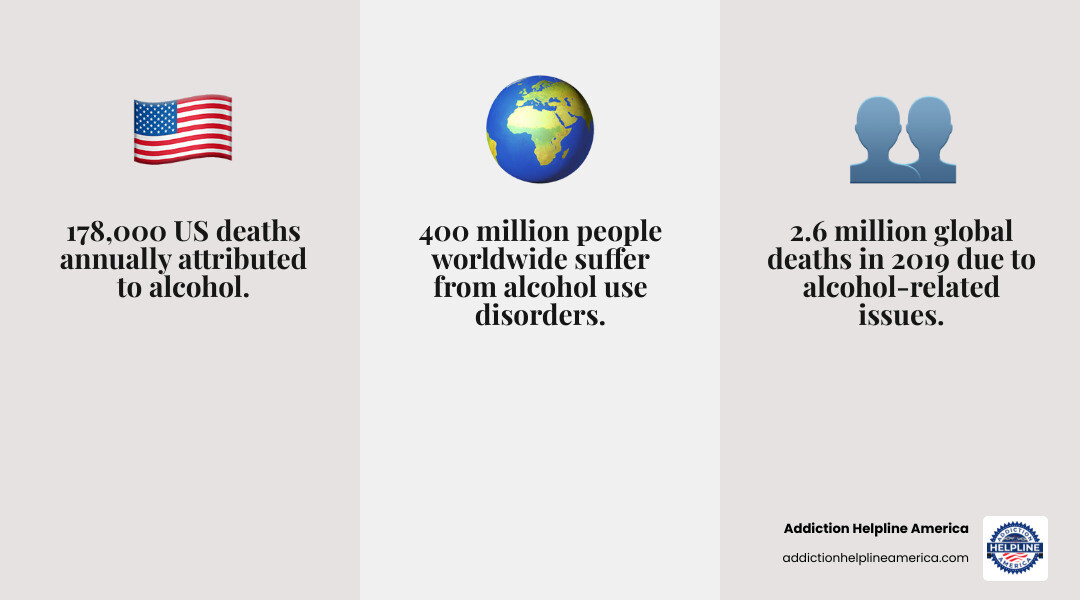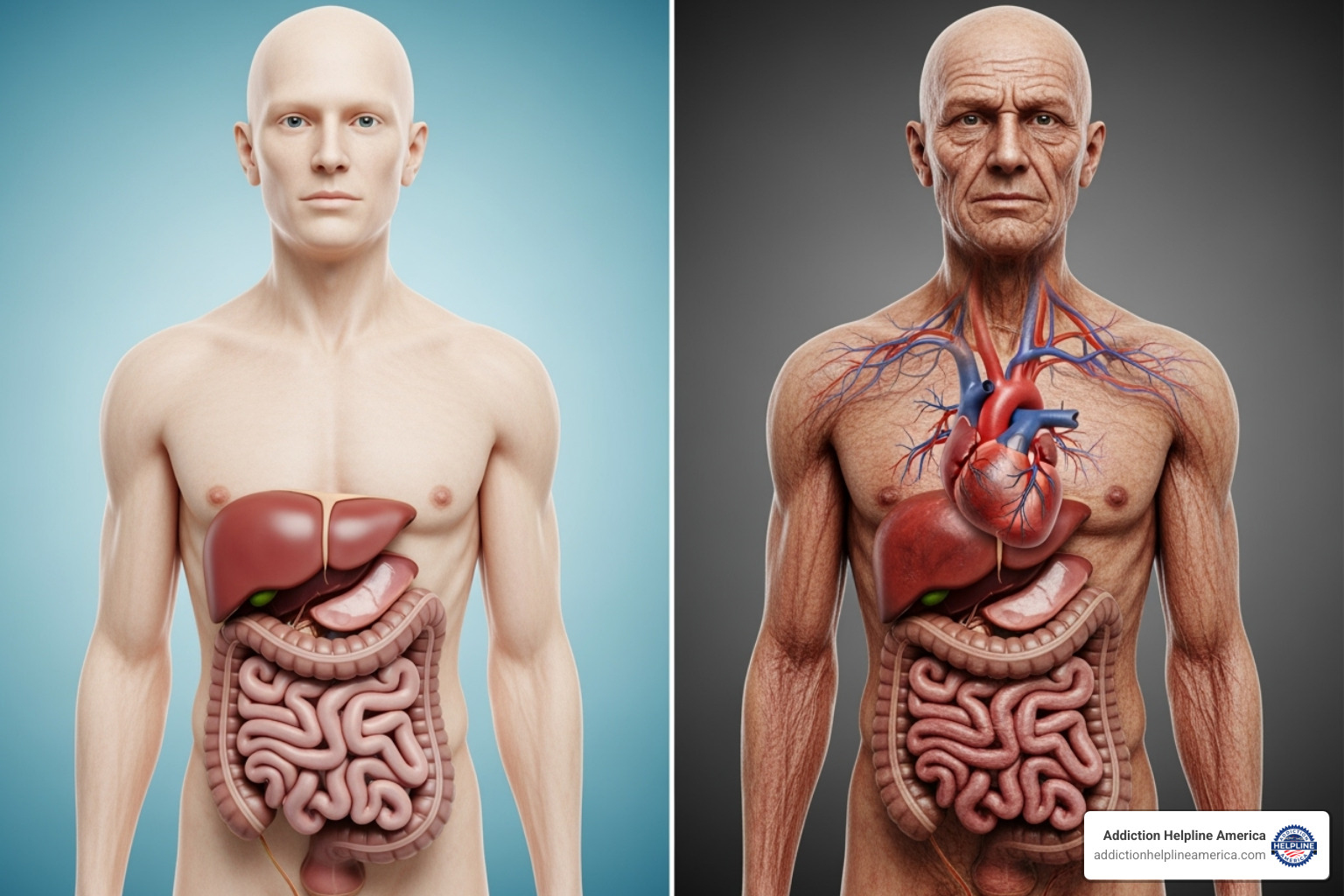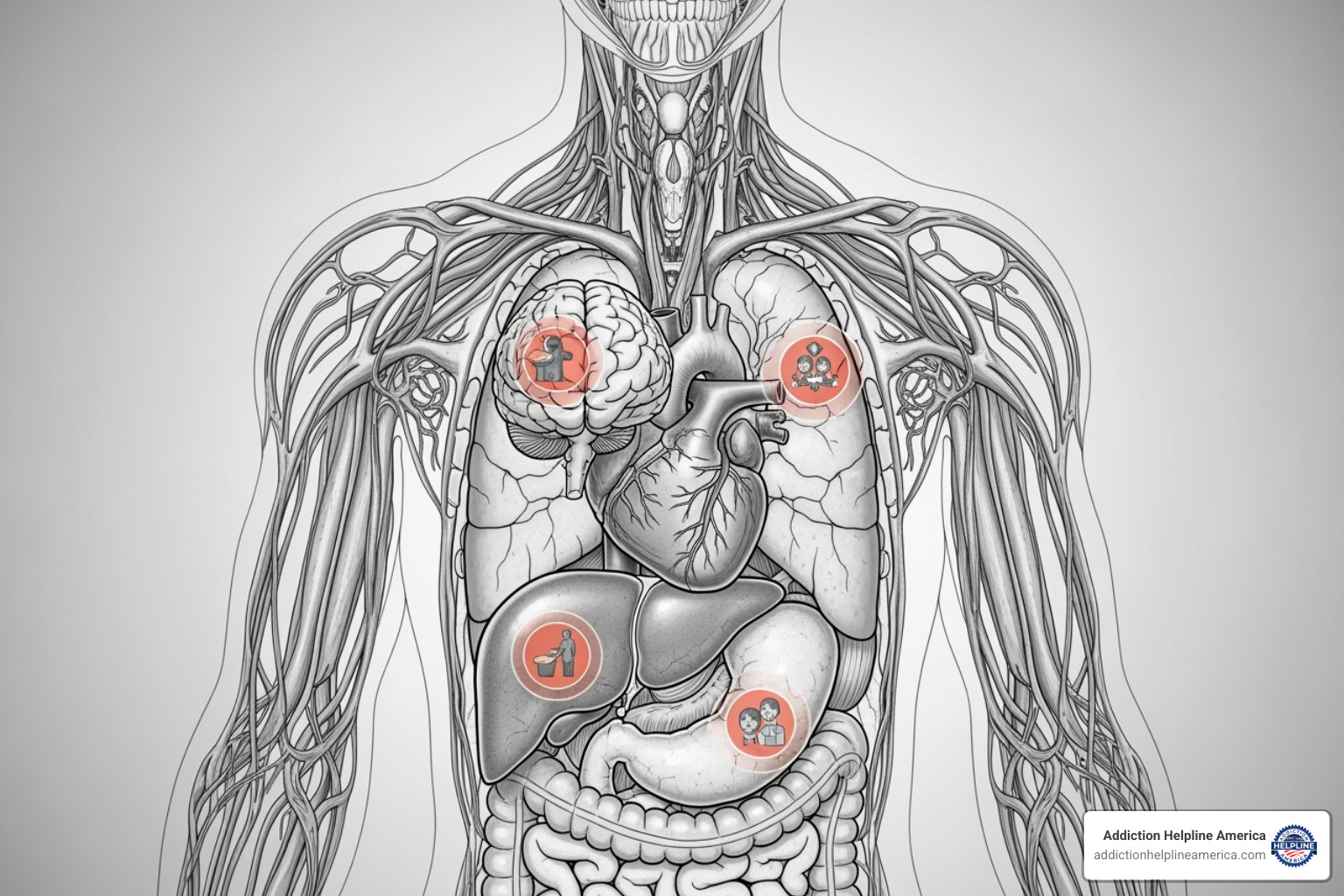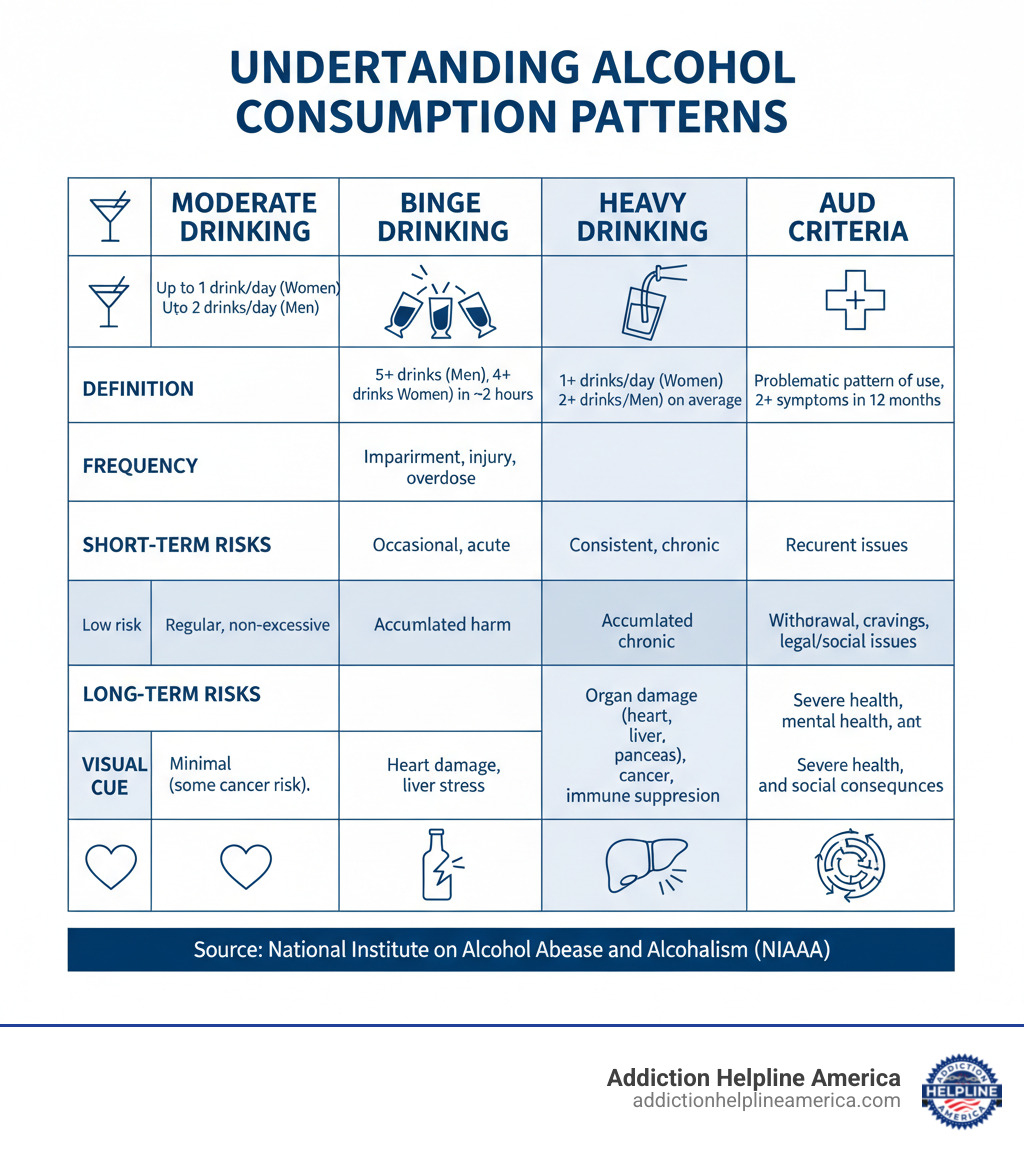
Alcohol Related Issues: Understanding the Impact on Health and Life
Understanding alcohol related issues is a critical public health concern, impacting individual well-being on a global scale. The consequences range from immediate dangers like accidents and alcohol poisoning to long-term health conditions, mental health struggles, and severe social and economic problems. Alcohol misuse affects millions, posing a serious threat to lives and communities.
Here’s a quick look at what alcohol related issues involve:
- Immediate Health Dangers: These include injuries from falls, motor vehicle crashes, or violence. Alcohol poisoning is another serious, life-threatening risk.
- Long-Term Health Risks: Excessive alcohol use can lead to chronic diseases. This includes various cancers, heart disease, and severe liver damage.
- Mental Health Impact: Alcohol misuse often worsens mental health conditions like anxiety and depression. It can also impair memory and learning.
- Social and Economic Consequences: Problems with alcohol can cause family break-ups, job loss, financial difficulties, and legal troubles.
- Alcohol Use Disorder (AUD): This is a chronic condition where an individual struggles to control their drinking, despite negative impacts on their life.
At Addiction Helpline America, we understand the complexities of alcohol related issues. We offer compassionate, confidential support, helping individuals and families find effective treatment and resources for lasting recovery through our team of experienced specialists.

Alcohol related issues glossary:
The Immediate Dangers and Long-Term Consequences of Alcohol Use

Alcohol is a powerful chemical that affects nearly every part of the body. The liver can only process a small amount at a time, meaning the rest circulates and can cause damage. Both a single episode of heavy drinking and long-term misuse can lead to serious health problems. Understanding these impacts is the first step toward making healthier choices.
Short-Term Health Risks: The Acute Effects of Drinking
Even a single instance of excessive drinking can lead to immediate and serious health risks that can be life-threatening.
One of the most common dangers is injuries. Alcohol impairs judgment and coordination, increasing the risk of motor vehicle crashes, falls, drowning, and burns. It is a major factor in many emergency room visits.
Violence is another tragic consequence. Alcohol can lower inhibitions and cloud judgment, leading to aggression. It is linked to homicide, suicide attempts, sexual violence, and intimate partner violence.
Alcohol use increases risky sexual behaviors, leading to a higher chance of sexually transmitted infections or unplanned pregnancies. For pregnant individuals, any alcohol use can cause miscarriage, stillbirth, or Fetal Alcohol Spectrum Disorders (FASDs).
Perhaps the most severe immediate risk is alcohol poisoning, a medical emergency where a toxic amount of alcohol shuts down vital body functions like breathing. Other acute risks include hypothermia and an increased risk of suicide attempts.
Long-Term Health Risks and Chronic Alcohol Related Issues
Years of excessive drinking can cause a ripple effect of health problems throughout your body.
Your liver is severely affected by chronic heavy drinking, which can cause alcohol-associated liver disease (ALD). This condition can progress from a fatty liver (steatosis) to alcoholic hepatitis, and finally to cirrhosis—severe scarring that leads to liver failure.
Your heart and cardiovascular system are also damaged. Long-term heavy drinking can cause high blood pressure, increasing the risk of heart disease and stroke. It can also lead to a weakened heart muscle (cardiomyopathy) and irregular heartbeats (arrhythmias).
Cancer is a major risk, as alcohol is a known carcinogen. Excessive use increases the risk for cancers of the breast, mouth, throat, esophagus, liver, and colon. Even moderate drinking can increase this risk. More information about alcohol and cancer risk is available in the Surgeon General’s advisory.
Chronic alcohol use also causes painful digestive problems, like gastritis and ulcers, and can severely weaken your immune system, increasing susceptibility to infections such as pneumonia.
How Alcohol Affects Every System in Your Body

Alcohol travels through the bloodstream to every organ, causing systemic damage. Understanding this widespread impact reveals the true scope of alcohol related issues.
Brain and Nervous System
Alcohol’s effects are first noticed in the brain, causing clouded judgment, slurred speech, and poor coordination. Over time, heavy drinking can shrink the brain and damage cells responsible for memory and learning.
Long-term misuse can lead to serious neurological conditions. Wernicke-Korsakoff syndrome, caused by a thiamine (vitamin B1) deficiency, begins with confusion and poor coordination. If untreated, it can progress to permanent, severe memory loss.
Alcoholic neuropathy involves nerve damage in the arms and legs, causing debilitating numbness, tingling, pain, or weakness.
Adolescent brains are still developing, making them uniquely vulnerable. Alcohol can permanently disrupt brain development, increasing the risk for addiction and other future problems.
Heart and Cardiovascular System
Excessive drinking seriously damages the cardiovascular system. It is a major cause of high blood pressure, which increases the risk of heart attacks and strokes. Both binge drinking and chronic heavy use can trigger arrhythmias (irregular heartbeats) like atrial fibrillation, which can lead to blood clots and heart failure. Over time, alcohol can weaken the heart muscle, a condition called alcoholic cardiomyopathy. Even moderate drinking can increase stroke risk. Research on alcohol’s impact on the cardiovascular system highlights these complex dangers.
Liver, Pancreas, and Digestive System
The liver is severely damaged by processing alcohol, with nearly all heavy drinkers developing some form of liver damage. Alcohol-associated liver disease (ALD) progresses from steatosis (fatty liver) to alcoholic hepatitis (inflammation), and finally to cirrhosis (irreversible scarring). Cirrhosis can lead to liver failure, liver cancer, and is a leading cause of alcohol-related deaths and liver transplants in the U.S.
The pancreas is also at risk. Alcohol is a leading cause of acute and chronic pancreatitis, painful conditions that impair digestion and can lead to diabetes. Alcohol also irritates the entire digestive tract, causing gut inflammation, GERD, and increasing the risk of serious gastrointestinal bleeding.
Other Affected Body Systems
Alcohol related issues extend to other body systems as well.
- Immune System: Alcohol suppresses the immune system, increasing vulnerability to infections like pneumonia and slowing wound healing.
- Endocrine System: Heavy drinking disrupts hormone regulation, affecting metabolism, reproductive function, and stress response, and can worsen conditions like Type 2 diabetes.
- Musculoskeletal System: Alcohol weakens bones (osteoporosis), increases fracture risk, and can cause muscle wasting (alcoholic myopathy). It is also a trigger for gout.
- Blood: Chronic heavy drinking can interfere with blood cell production, leading to anemia, increased infection risk (leukopenia), and clotting problems (thrombocytopenia).
This systemic damage underscores why excessive alcohol consumption is a major public health concern.
Understanding Problematic Drinking: From Bingeing to Alcohol Use Disorder
Alcohol related issues can develop from different patterns of consumption. It’s important to understand the distinction between drinking a large amount at once versus a consistent pattern over time. Recognizing these patterns is the first step toward identifying a potential problem.

Defining Excessive Alcohol Use
Excessive alcohol use includes:
- Binge drinking: Consuming enough alcohol in about 2 hours to bring your blood alcohol concentration (BAC) to 0.08% or higher. This is typically 5 or more drinks for men or 4 or more drinks for women.
- Heavy drinking: Defined by weekly consumption. For women, it is 8 or more drinks per week. For men, it is 15 or more drinks per week.
To understand these definitions, it’s crucial to know what a “standard drink” is. According to the National Institute on Alcohol Abuse and Alcoholism (NIAAA), one standard drink is:
- 12 ounces of regular beer (about 5% alcohol)
- 8-9 ounces of malt liquor (about 7% alcohol)
- 5 ounces of wine (about 12% alcohol)
- 1.5 ounces of 80-proof (40% alcohol) distilled spirits (like gin, rum, vodka, or whiskey)
The U.S. Dietary Guidelines for alcohol offer more details on safe consumption.
What is Alcohol Use Disorder (AUD)?
Alcohol Use Disorder (AUD), also known as alcoholism, is a chronic brain disease characterized by an inability to control drinking despite negative consequences. It is a medical condition, not a moral failing, and is diagnosed based on criteria from the DSM-5. The severity—mild, moderate, or severe—depends on the number of symptoms present. Common signs include:
- Drinking more or longer than intended.
- Unsuccessful attempts to cut down or stop.
- Spending a great deal of time obtaining, using, or recovering from alcohol.
- Experiencing strong cravings.
- Neglecting responsibilities at work, school, or home due to drinking (social and occupational impairment).
- Continuing use despite social or interpersonal problems.
- Using alcohol in hazardous situations.
- Developing tolerance (needing more to get the same effect).
- Experiencing withdrawal symptoms (shaking, anxiety, nausea) when not drinking.
Even a few signs are a cause for concern, as a mild AUD can worsen over time. The facts about alcohol use disorder from the NIAAA are a valuable resource.
Risk Factors and the ‘Kindling’ Effect
The development of AUD is complex, with multiple risk factors. These include genetics and family history, psychological factors like stress and depression, starting to drink at an early age, and one’s social environment.
The ‘kindling’ effect is a serious concern where repeated episodes of alcohol withdrawal lead to progressively more severe symptoms. An initial withdrawal might cause mild anxiety, while later ones could involve hallucinations or life-threatening seizures. This occurs because the brain becomes more sensitive with each withdrawal cycle, highlighting the need for medical support during detox. You can read more about kindling in alcohol withdrawal (PDF, 163kb) for more details.
The Wider Impact of Alcohol Related Issues on Life and Society
The consequences of alcohol related issues extend beyond individual health, impacting families, communities, and the economy. Alcohol misuse affects mental health, social well-being, and creates significant societal burdens.

Special Risks: Underage Drinking and Pregnancy
Certain situations carry especially high risks, particularly underage drinking and alcohol use during pregnancy.
Underage drinking poses serious threats to the developing adolescent brain, potentially causing long-term issues with memory and learning. It also increases the risk of developing Alcohol Use Disorder (AUD) later in life, as well as involvement in accidents, violence, and risky behaviors.
There is no known safe amount of alcohol during pregnancy. Drinking during pregnancy can cause Fetal Alcohol Spectrum Disorders (FASDs), a range of lifelong conditions affecting the child. FASDs can lead to:
- Physical defects, such as distinct facial features or heart problems.
- Intellectual disabilities and learning challenges.
- Behavioral problems, like hyperactivity and poor impulse control.
FASDs are a leading cause of preventable intellectual disability and birth defects. You can find more Information on Fetal Alcohol Spectrum Disorders (FASDs) from the CDC.
Social and Economic Alcohol Related Issues
Widespread alcohol related issues strain community connections and have devastating personal impacts for those struggling:
- Family problems: Alcohol misuse contributes to domestic abuse, child neglect, marital conflict, and divorce.
- Unemployment and financial difficulties: Poor work performance can lead to job loss, financial instability, and poverty.
- Legal issues: Drunk driving (DUIs), violence, and other crimes can result in arrests, fines, and jail time.
The societal financial burden is staggering, costing the U.S. hundreds of billions annually. These costs include healthcare expenses, lost productivity, and criminal justice system resources.
Alcohol’s Toll on Mental Health and Cognition
The link between alcohol and mental health is complex and cyclical. Alcohol misuse can trigger or worsen mental health conditions, and vice-versa. Co-occurring disorders are common; many with AUD also have depression, anxiety, or PTSD. In 2023, 20.4 million U.S. adults had both a substance use and mental health disorder.
While alcohol may seem to offer temporary relief from stress, it is a depressant that ultimately worsens mental health symptoms. It can deepen depression, disrupt sleep, and increase anxiety as it wears off.
Chronic misuse also leads to lasting cognitive decline, including memory loss, poor judgment, and learning difficulties, which can complicate daily life and recovery. Tragically, Alcohol Use Disorder contributes to 1 in 4 suicide deaths.
Navigating Your Relationship with Alcohol: Guidelines and Getting Help
Understanding the risks of alcohol related issues is the first step. The next is to make informed choices by reassessing your relationship with alcohol, spotting potential problems, and knowing when to seek help. Clear paths exist for cutting back or finding treatment.
What are the Recommended Guidelines for Moderate Drinking?
To reduce the risk of alcohol related issues, health organizations provide guidelines for moderate drinking, though no amount is 100% safe. According to the U.S. Dietary Guidelines, for adults who choose to drink:
- For men, moderate drinking means having 2 drinks or less in a day.
- For women, it’s recommended to have 1 drink or less in a day.
These are daily limits, not weekly averages that can be “banked” for one day. For many people, including those who are pregnant, have certain health conditions, or a history of Alcohol Use Disorder (AUD), abstaining from alcohol is the safest choice.
How to Assess Your Drinking Habits
If you are questioning your drinking habits, there are several ways to assess them. Self-reflection is a powerful tool. Ask yourself honestly:
- Do I drink more or for longer than I intend?
- Have I tried to cut down but couldn’t?
- Do I spend a lot of time drinking or recovering from it?
- Do I experience strong cravings for alcohol?
- Has my drinking caused problems with my health, work, or relationships?
- Do I continue drinking despite these problems?
You can also use confidential online screening tools from the NIAAA or talk to your doctor. A healthcare provider can perform a Screening and Brief Intervention (SBI) to assess your risk, discuss options, and guide you toward treatment options. Regular alcohol screening is a proactive step for your health.
If you decide to reduce your intake, strategies for cutting back include setting limits, alternating with non-alcoholic drinks, avoiding triggers, and finding new ways to socialize without alcohol. Making informed choices is a sign of self-care.
Recognizing an Emergency: Alcohol Poisoning
Alcohol poisoning is a life-threatening emergency caused by drinking too much alcohol too quickly, which can shut down vital body functions. If you suspect alcohol poisoning, you must act fast.
Here are the critical signs and symptoms to look out for:
- Confusion or disorientation.
- Uncontrolled vomiting.
- Seizures.
- Slow breathing (fewer than eight breaths per minute) or irregular breathing (pauses of 10 seconds or more).
- Pale or bluish, cold, clammy skin.
- Being in a stupor (conscious but unresponsive).
- Unconsciousness or being impossible to wake up.
What to do in an emergency – these steps could save a life:
- Call 911 (or your local emergency number) right away.
- Stay with the person and do not leave them alone.
- Carefully turn the person on their side to prevent choking on vomit.
- Do NOT try to make them vomit.
- Do NOT give them coffee or try to “walk them around.” These myths are ineffective and can be dangerous.
- Provide information to emergency responders, including what and how much the person drank.
Blood alcohol levels can continue to rise even after a person stops drinking. Never assume they can “sleep it off.” Always call for emergency help.
Conclusion: Taking the First Step Towards Recovery
We’ve covered the far-reaching impact of alcohol related issues, from immediate dangers like accidents to long-term health problems affecting the entire body. We’ve also seen how alcohol misuse harms mental well-being, families, and communities.
Amidst these challenges, there is hope. Alcohol Use Disorder is a treatable condition, and recovery is possible. The bravest step is recognizing the problem and reaching out for help.
At Addiction Helpline America, we understand just how overwhelming navigating the path to recovery can feel. You might be asking, “Where do I even start?” Please know, you absolutely don’t have to walk this journey alone. Our dedicated team is here to offer you free, confidential, and personalized guidance. We’re passionate about connecting individuals and families with the right treatment centers and vital resources, no matter where you are in the nation. This includes folks in:
Alabama, Alaska, Arizona, Arkansas, California, Colorado, Connecticut, Delaware, Florida, Georgia, Hawaii, Idaho, Illinois, Indiana, Iowa, Kansas, Kentucky, Louisiana, Maine, Maryland, Massachusetts, Michigan, Minnesota, Mississippi, Missouri, Montana, Nebraska, Nevada, New Hampshire, New Jersey, New Mexico, New York, North Carolina, North Dakota, Ohio, Oklahoma, Oregon, Pennsylvania, Rhode Island, South Carolina, South Dakota, Tennessee, Texas, Utah, Vermont, Virginia, Washington, West Virginia, Wisconsin, Wyoming, and the District of Columbia.
If you or someone you care about is struggling with alcohol related issues, please don’t hesitate. Reach out today. We’re here to support your journey towards a healthier, more peaceful, and truly fulfilling life. Find confidential help for alcohol related issues today.
Our helpline is 100%
free & confidential
If you or someone you care about is struggling with drug or alcohol addiction, we can help you explore your recovery options. Don’t face this challenge alone—seek support from us.
Programs
Resources
Will my insurance
cover addiction
treatment?
We're ready to help
Find the best
drug or alcohol treatment
center
Are you or a loved one struggling with addiction? Call today to speak to a treatment expert.












